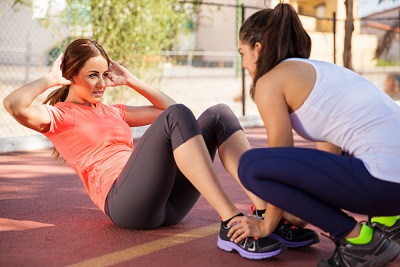Better Ab Training Techniques
The reverse crunch exercise may be the best alternative to traditional crunches.
The Reverse Crunch Vs. The Traditional Crunch
For years sit-ups and crunches have been used by everyone from athletes to the average workout enthusiast.
When crunching was introduced, this was an instant improvement on old school sit-ups. However, today crunches still aren’t believed to be all that effective and safe for developing six pack abs.

The first mistake was believing that the abdominal (core) muscles should be trained just like every other muscle group in the human body.
The belief was that you would get similar results to increased muscle size, strength, burning fat, etc by focusing on muscle contraction. Therefore, in order to contract a muscle, you focus on flexing the muscles, right? Here lies the problem.
The problem with this thinking? In real life, the abs DON’T work the same way that other muscle groups do.
Want bigger biceps? Focus on dumbbell bicep curls that contract and flex the biceps.
Want bigger thighs? Focus on leg extensions that contract and flex the hamstrings. Leg lifts that contract and flex the quadriceps.
Flexion and extension at the knee joint? May not be that big a deal.
Flexion and extension at the spine? Kinda a big deal.
Training your abs is different in that the core doesn’t work by flexing.
The role of your abs is stability. The abs job is more about preventing movement, not creating it.
Flexing your torso isn’t functional and can actually cause back pain and injury.
The crunch was an improvement on the sit-up because there is less range of motion when flexing the spine.
But again, this isn’t how your abs work in real life. Your abs work to support your spine, not flex it.
So if sit-ups and crunches aren’t the most effective way to train, then how do I train my abs?
How do I train my abs without flexing my spine?
Reverse Crunch Exercise
Two important advantages to the reverse crunch…
1. Less lumbar flexion than a traditional crunch. Going from lumbar flexion to more lumbar flexion is going to be more problematic than going from a more extended position to get into flexion to get to neutral.
2. Better for the external obliques. Getting external oblique recruitment without ripping your rib cage down and putting you in a more kyphotic position.
Performing the Reverse Crunch
Start positioned on your back with knees bent. Place medicine ball or other object resting on the floor above your head.
The first thing you need to do is learn how to posteriorly tilt your pelvis. To do this, you need to tilt your pelvis back to help flatten the back against the floor.
Place a foam roller or other object between your ankles and buttocks. Clamp the foam roller against your buttocks and place your hands on the medicine ball.
The med ball keeps you in place while you peform the reverse crunch exercise.
Get in the little bit of posterior tilt position and do the reverse crunch.
You’ll go into a little bit of flexion. You’re in the posterior tilt, but not end range lumbar flexion.
You’ll notice you’re not in a kyphotic position at the top of the crunch.
You want good thoracic extension while maintaining good rib cage posture.
To make the exercise more difficult, use a lighter weight to anchor.
If you enjoyed these tips and would like to keep it close to you at any time, just save this pin to your Pinterest Ab Training Board.

Home › Crunching Tips ›Reverse Crunch Exercise